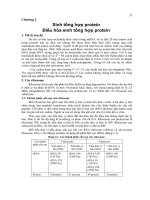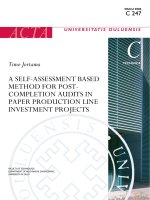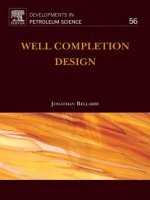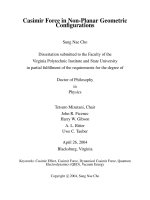C2 wellbore completion configurations
Bạn đang xem bản rút gọn của tài liệu. Xem và tải ngay bản đầy đủ của tài liệu tại đây (2.17 MB, 38 trang )
Designed & Presented by
Mr. ĐỖ QUANG KHÁNH, HCMUT
12/2010
Đỗ Quang Khánh – HoChiMinh City University of Technology
Email: or
1
The interface between the wellbore and reservoir
(bottom hole completion techniques): open hole
completions; uncemented liner completions;
perforated completion…
Production method: pumping; flowing… => selection
of flow conduit between reservoir and surface
Number of zones to be completed: single or multiple
12/2013
Đỗ Quang Khánh – HoChiMinh City University of Technology
Email: or
2
Bottom Hole Completion Techniquess
(a) openhole completion; (b) uncemented liner completion; (c) perforated completion)
Openhole Completions
o
In an openhole or barefoot completion, the production casing is set in the caprock above or just into the top of the pay zone,
while the bottom of the hole is left uncased
o
o
Advantages:
Exposure of entire pay zone to the wellbore;
No perforating expense; reduced casing cost
less critical need for precise log interpretation;
Reduced drawdown because of the large inflow area;
Slightly reduced casing cost;
Ease of deepening the well;
relative ease of converting the well to a liner completion;
no risk of formation damage resulting from cementing casing.
Disadvantages:
inability to control excessive gas-oil and/or water-oil ratios (except in the case of bottom water);
need to set casing before drilling or logging the pay;
difficulty of controlling the well during completion operations;
unsuitability for producing layered formations consisting of separate reservoirs with incompatible fluid properties;
inability to selectively stimulate separate zones within the completion interval ;
need for frequent clean-outs if the producing sands are not completely competent or if the shoulder of the caprock between the shoe and top of the pay
is not stable.
Uncemented Liner Completions
o
To overcome the problems of collapsing sands plugging the production system, the early oil producers placed slotted pipe or
screens across the openhole section as a downhole sand filter .
o
o
Advantages:
No formation damage due to completion work
no perforation required
log interpretation is not critical;
Easy to control sand production
Adaptable to other special techniques to control sand
Cleanout problem can be avoided
Deepening of the well can be accomplished easily
Not recommended for the following reasons:
Sand movement into the wellbore tends to cause permeability impairment by the intermixing of sand sizes, and of
sand and shale particles.
Fine formation sands tend to plug the slots or the screen.
At high rates, the screen often erodes as formation sand moves into the wellbore.
Poor support of the formation can cause shale layers to collapse and plug the slots or screen.
Formation failure can cause the liner itself to collapse.
Cemented and Perforated Completions
By far the most common type of completion today involves cementing the
production casing (or liner) through the pay zone, and subsequently providing
communication with the formation by perforating holes through the casing and
cement.
Safer operations
More informed selection of the zones to be completed
Reduced sensitivity to drilling damage
Facilitation of selective stimulation
Possibility of multizone completions
Easier planning of completion operations
Selection of flow conduit between
reservoir
and
surface
In the selection of the method, a range of considerations may influence the choice
including: cost, flow stability, ability to control flow and ensure well safety or isolation;
ensuring that the integrity of the well will not be compromised by corrosion or erosion.
In the case of multizone reservoir, the zonal characteristics will determine to a large
extent the flow system selected.
However, for a single zone completion, the following alternatives exist:
1.
Tubingless casing flow.
2.
Casing and tubing flow.
3.
Tubing flow without annular isolation.
4.
Tubing flow with annular isolation.
Single-String Completions (Single Zone)
(a) temporary; (b) tubingless gas well; (c) simple low cost; (d) high pressure; (e) high-rate liner completion)
Multiple-String Completions (Multiple
Zone)
(a) tubingless; (b) low rate, single string; (c) high rate, single string; (d) dual string (parallel gas lift);
(e) concentric.
Commingled Completion
Oilfield Glossary Definition:
A wellbore completed in two or more reservoir zones that
are not in hydraulic communication in the
reservoir. Backflow (often incorrectly referred to
as crossflow) is common during rate cutbacks and
buildup tests on these types of completions.
Why Commingle?
It is not economical to produce each pool separately.
Even though producing each pool individually may be economic, there
is a substantial improvement in the economics when the production is
commingled.
It would take too long to produce the reserves sequentially.
When one pool's production is not able to lift liquids in the wellbore,
and would otherwise be abandoned, commingling can assist in the
lifting of liquids thus allowing those reserves to be produced.
Why NOT Commingle?
If one of the pools contains sour gas and the other is sweet.
When there is a substantial pressure difference between pools.
If one of the pools produces a lot of water. If the pools are so geologically
different that their produced water (even small quantities) may create
incompatibilities and/or adverse rock-water interactions (clay swelling, water
blocks). This is not likely to happen in geologically similar formations.
If it is absolutely imperative to be able to conduct accurate Material Balance
calculations in the future.
Where ownership of pools differ.
Define a range of operations or capabilities required. Some of the
capabilities are considered to be essential, such as those providing
operational security or safety, whilst others can provide improved
performance or flexibility.
As the degree of flexibility provided by the completion is increased, the
more complex is the design process and normally a sophisticated design
will result which includes a large number of string components.
With the inbuilt complexity, the reliability of the completion string
becomes more suspect. => the design process should be approached by
initially identifying the minimum functional requirements and any
additional options are assessed on the basis of incremental complexity
versus incremental benefit.
12/2013
Đỗ Quang Khánh – HoChiMinh City University of Technology
Email: or
13
The essential attributes for the majority of completion string
installations:
(a) The ability to contain anticipated flowing pressure and any hydraulic pressures
which may be employed in well operations and conduct fluid to surface
(production) or the reservoir (injection wells) with minimal flowing pressure loss
and optimal flow stability.
(b) The ability to isolate the annulus between the casing and the production tubing if
flow instability is likely or it is desirable to minimise reservoir fluid contact with
the production casing.
(c) The ability to affect downhole shut-in either by remote control or directly activated
by changing well flowing conditions, in the event that isolation at surface is not
possible.
(d) A means to communicate or circulate (selectively when required) between the
annulus and the tubing.
(e) A provision for physical isolation of the tubing by the installation of a plug to allow
routine isolation e.g. for pressure testing of the tubing.
12/2013
Đỗ Quang Khánh – HoChiMinh City University of Technology
Email: or
14
A range of other functions may be necessary or considered worthwhile
for incorporation into the string design as a future contingency.
Some of the more prevalent :
(a) Downhole tubing detachment
(b) Tubing stresses
(c) Ability to suspend P & T monitoring equipment
(d) Controlled fluid injection from the annulus into tubing
(e) Downhole pump system
(f)
Wireline entry guide
12/2013
Đỗ Quang Khánh – HoChiMinh City University of Technology
Email: or
15
12/2013
Đỗ Quang Khánh – HoChiMinh City University of Technology
Email: or
16
The design of the completion string involves the selection and
specification of all the component parts of the string.
In selecting equipment, this should be done on the basis that the
component will provide a specific facility deemed necessary to
the successful performance and operation of the well under a
range of operating scenarios.
Each component adds undesirable complexity to the completion
and this must be compensated for by the fact that it is necessary
or provides desirable flexibility.
12/2013
Đỗ Quang Khánh – HoChiMinh City University of Technology
Email: or
17
The wellhead provides the basis for the mechanical construction
of the well at surface or the sea-bed:
1)
Suspension of all individual casings and tubulars, concentrically
in the well
2)
Ability to install a surface closure/flow control device on top of
the well namely:
i)
A blow out preventer stack whilst drilling
ii)
A Xmas tree for production or injection
3)
Hydraulic access to the annuli between casing to allow cement
placement & between the production casing & tubing for well
circulation
12/2013
Đỗ Quang Khánh – HoChiMinh City University of Technology
Email: or
18
12/2013
Đỗ Quang Khánh – HoChiMinh City University of Technology
Email: or
19
The purpose of the Xmas tree is to provide valve control of the
fluids produced from or injected into the well.
The Xmas tree is normally flanged up to the wellhead system
after running the production tubing. There are a number of basic
designs for Xmas trees.
Briefly, it can be seen that it comprises 2 wing valve outlets, normally one for
production and the other for injection, e.g. well killing.
Additionally, the third outlet provides vertical access into the tubing for wireline
concentric conveyancing of wireline or coiled tubing tools.
The lower valve is the master valve and it controls all hydraulic and mechanical
access to the well. In some cases, the importance of this valve to well safety is so
great that it is duplicated.
All outlets have valves which in some cases are manually operated or in the case
of sophisticated platform systems and subsea remotely controlled hydraulic valves
operated from a control room.
12/2013
Đỗ Quang Khánh – HoChiMinh City University of Technology
Email: or
20
The size and pressure ratings of wellheads are dictated by design
considerations for the tubular:
•
•
•
•
tubing size
casing size
kill and stimulation pressure requirements
flowing pressure requirements
However, government regulations sometimes require that the
rating of upper part of the wellhead be at least equal to the
reservoir pressure.
12/2013
Đỗ Quang Khánh – HoChiMinh City University of Technology
Email: or
21
When selecting production tubing, the following data has to be
specified:
(a) The grade of steel selected for the manufacture of the tubing, e.g. N80, C75 etc.
will be dependent on a number of factors such as the strength requirements for
the string and, the possible presence of corrosive components such as CO2 or
H2S.
(b) The wall thickness of the tubing referred to as a weight/foot of tubing, has to be
specified and this parameter controls the tubing body’s capacity to withstand
tensile/compressive stresses and differences between internal and external
pressures, e.g. 7" tubing is available as 26, 29, 32 lb/ft. etc.
(c) The threaded coupling is an important part of the design specification as it defines
both the tensile strength and the hydraulic integrity of the completion string. The
types of couplings available vary from API standard couplings such as Buttress
BTC, Extreme Line EL, Long Threaded Coupling LTC, etc.to the specialised or
premium threads commonly selected for production tubing such as Hydril, VAM,
etc. These latter proprietary designs offer specific advantages, e.g. VAM was
developed for completing high pressure gas wells, where rigorous sealing and
pressure integrity is difficult to achieve but essential.
12/2013
Đỗ Quang Khánh – HoChiMinh City University of Technology
Email: or
22
Tubing characteristics:
Tubing is made of seamless pipe, which is usually fitted with a coupling.
API schedules have a list of pipes. Some manufacturers make pipe from improved
steels or special steels.
Special steel pipe meets corrosion resistance requirements due to the presence of
H2S, CO2 and water
Parameter defined by API: nominal diameter, nominal weight, grade of steel, type
of connection and length range (range 1: from 20 to 24 ft; range 2: from 28 to 32
ft; for production string spacing out operations, short/pup joints are required: 2,
4, 6, 8, 10 and 12 ft as listed by API)
12/2013
Đỗ Quang Khánh – HoChiMinh City University of Technology
Email: or
23
Packer: a tool to provide a seal between the tubing & the casing
of a well to prevent movement of fluids past this sealing point.
The
pack-off is accomplished by expanding or extending the elastomer element
outwards from the packer body until it contacts the casing wall
Main Applications are:
Improve safety by providing a barrier to flow through the annulus.
Keep well fluids and pressures isolated from the casing
Improve flow stability conditions and prevent heading
Separate zones in the same wellbore
Place kill fluids/ treating fluids in the casing annulus
Keep gas lift or hydraulic power fluid injection pressure isolated from formation
Anchor the tubing
Isolate a casing leak or leaking liner lap
Facilitate temporary well service operations
12/2013
Đỗ Quang Khánh – HoChiMinh City University of Technology
Email: or
24
Four Main characteristics classifying packer types are:
Setting Mechanism
Mechanical-set (weight-set; compression or tension-set; rotational-set)
Hydraulic-set
Electrical packer
Retrievability
Retrievable packer
Permanent packer (wireline setting or tubing setting)
Ability to withstand differential pressure
Packer Bore
12/2013
Đỗ Quang Khánh – HoChiMinh City University of Technology
Email: or
25









